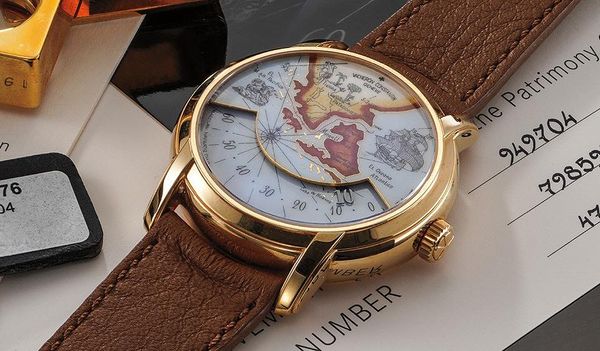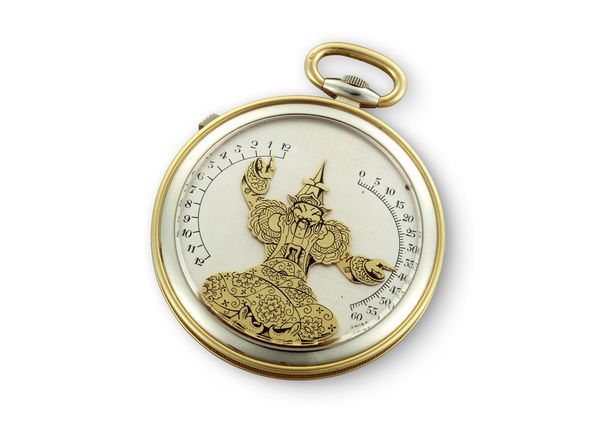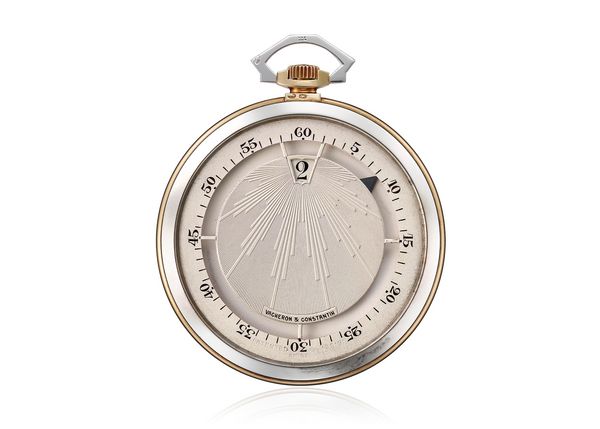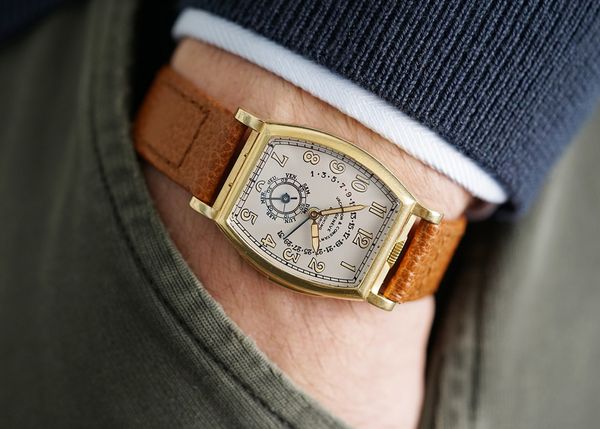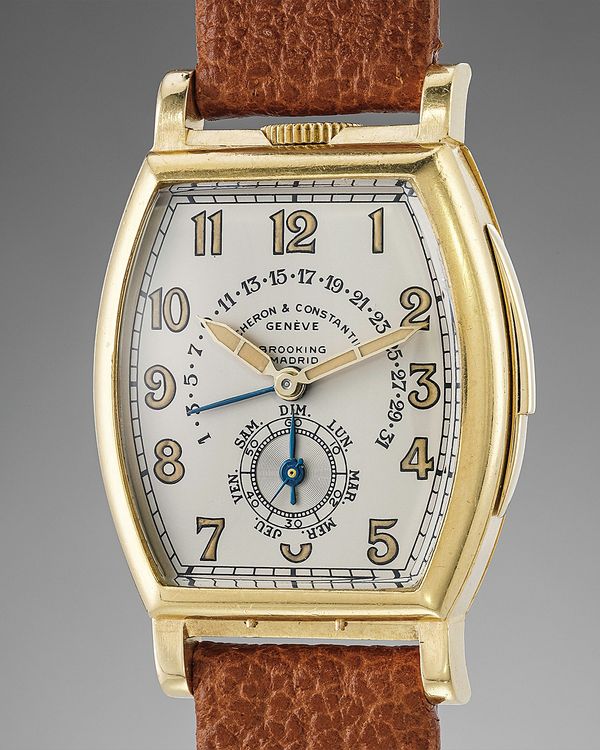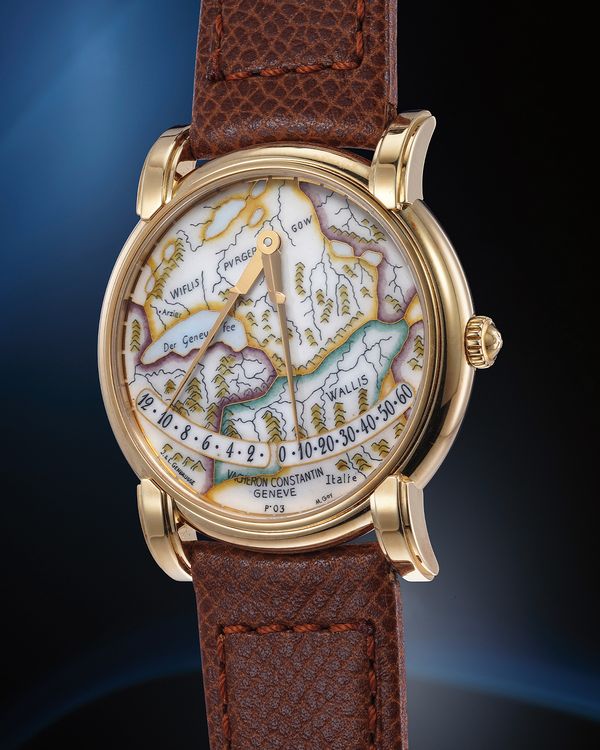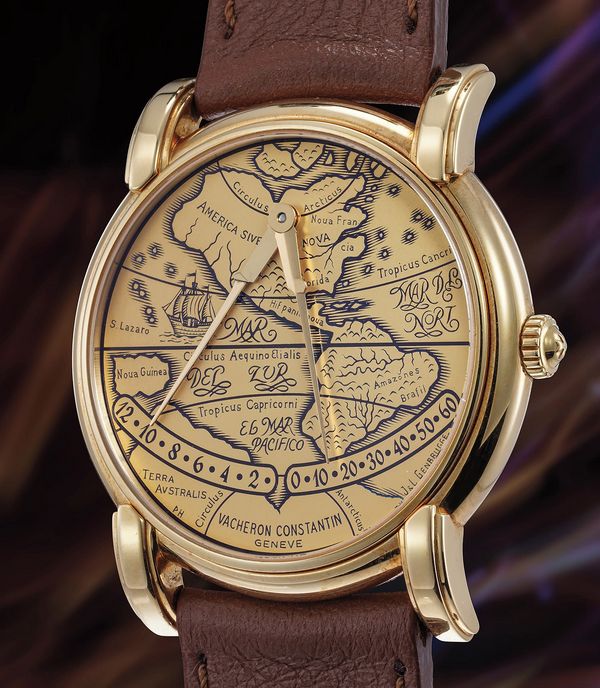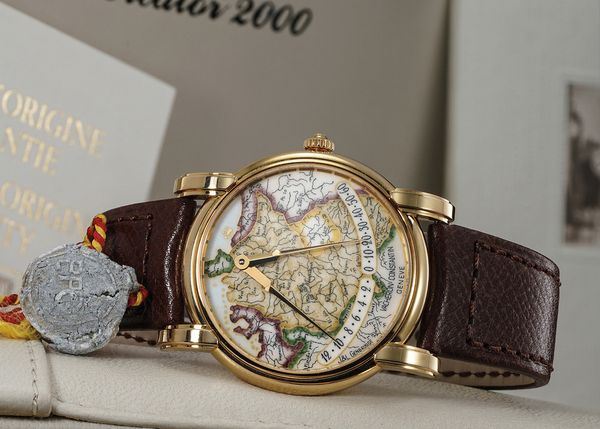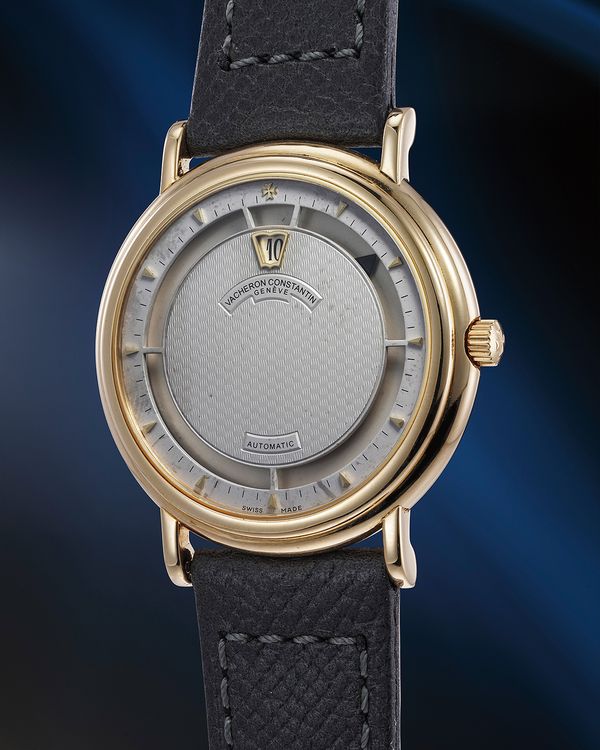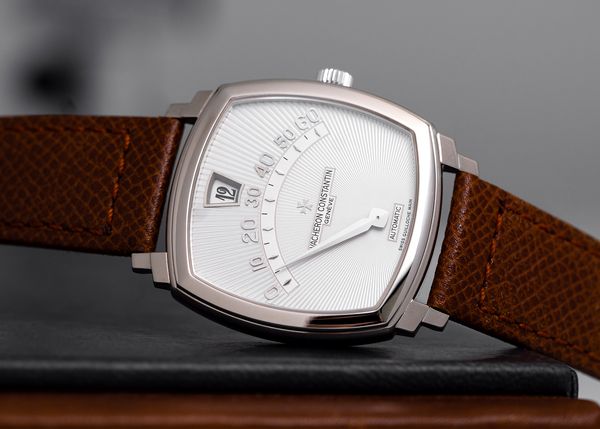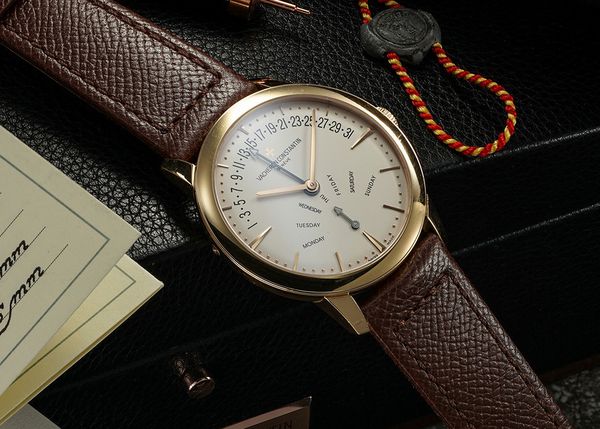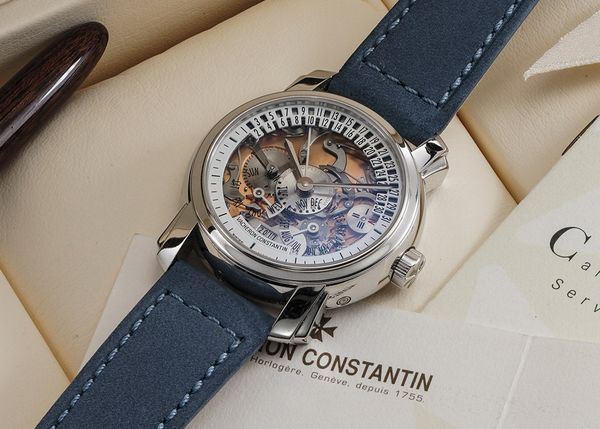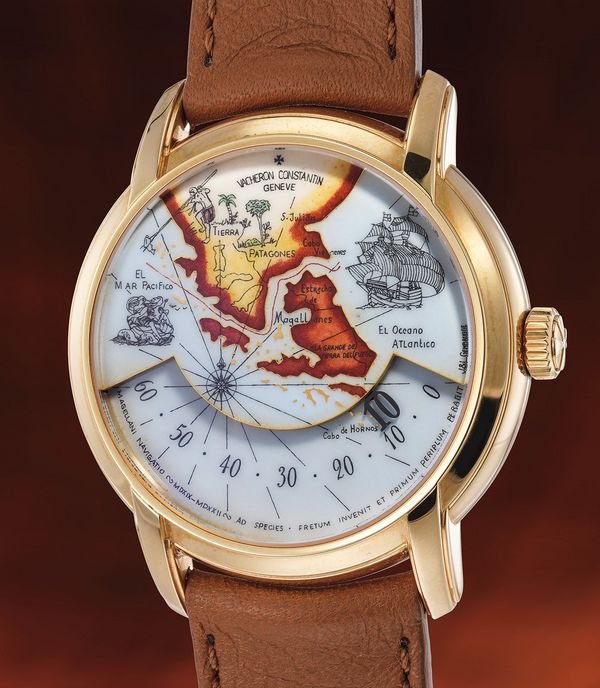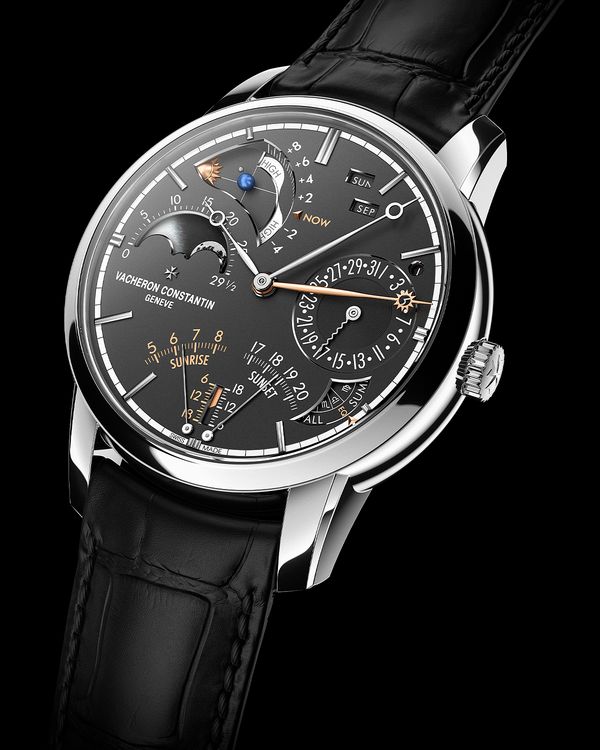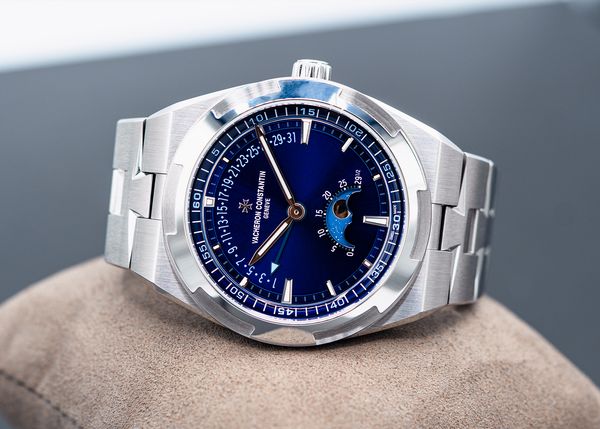Our first live auction of 2024, the PHILLIPS Geneva Watch Auction: XIX, takes place on May 11 and 12, at the Hotel President, at Quai Wilson 47 in central Geneva. The auction includes more than 215 of the world's finest watches – and though we are loath to boast, we truly think it's one of the best catalogs we've ever put together. We'll be highlighting a number of the most interesting lots and stories featured in the sale over the next month, including the circa 2010 Vacheron Constantin Hommage Aux Grands Explorateurs (lot 99) featured in this article.
– By Logan Baker
The Vacheron Constantin booth at Watches & Wonders this year was a bustling affair, but there was one word that seemed to hang off the tongue of every brand representative, media member, and passersby: retrograde.
This is the year of the retrograde for Vacheron Constantin, and the brand released a number of new watches containing the unique time display, including the new Overseas Moonphase Retrograde Date and the Traditionnelle Tourbillon Retrograde Date Openface.
But when the topic of “retrograde” and “Vacheron Constantin” comes up in the PHILLIPS office, a different watch comes to mind: the legendary “Don Pancho,” a one-of-a-kind 18k yellow gold tonneau-shaped minute-repeating wristwatch with a 31-day retrograde calendar that Vacheron Constantin built on special order for a Spanish client.
The watch was a myth for Vacheron Constantin lovers for decades. Those collectors had nothing to confirm the watch’s existence outside a small black-and-white photo featured in the 1992 book, The World of Vacheron Constantin. That changed in May 2019, when – after the watch was rediscovered by the family of the original owner in a safe that hadn’t been opened in over half a century – PHILLIPS auctioned the watch off during The Geneva Watch Auction: NINE, for CHF 740,000.
After meeting with Vacheron Constantin during Watches & Wonders, and refreshing my memory of the Don Pancho story, I started to think more seriously about Vacheron’s background in experimenting with alternative time displays. I’ve always enjoyed the Mercator and Saltarello from the 1990s, and I was very familiar with Vacheron’s current retrograde offerings, particularly the Patrimony Retrograde Day-Date that a friend of mine obsesses over. All of the sudden, I was able to picture countless Les Cabinotiers unique pieces with all sorts of funky time displays, including digital disc read-outs and wandering hours, to everything in between.
I realized that, taken together, all these watches weren’t just created and designed for pure novelty, or just for the sake of being different, Vacheron Constantin had a legitimate and impressive history in iterating on and developing new time display systems. And the more I read and researched, the deeper I fell down the rabbit hole of Vacheron’s unique design history.
I guess it shouldn’t be surprising, given Vacheron’s been kicking and ticking for longer than the United States of America has been a country – yup, Vacheron was founded in 1755 – but it’s genuinely remarkable how many interesting vintage pocket watches and modern and contemporary wristwatches Vacheron has created using all sorts of novel time display systems.
This story isn’t meant to be a comprehensive guide to every Vacheron Constantin watch ever created with an alternative or funky time display, but it should serve as an effective starting point in understanding the history, as well as appreciating how Vacheron has evolved in the modern era, as well.
In The Beginning
The earliest unconventional time display to appear on a Vacheron Constantin timepiece was a digital jumping hour indication – or heures sautantes – placed on an 1824 pocket watch; a jumping minutes display was deeveloped a few years after that.
Vacheron wouldn’t truly embrace its alternative side again over a century later. They first began to experiment with retrograde time systems on a series of Art Deco-inspired desk clocks in the 1920s. A few years down the road, in the 1930s, Vacheron Constantin introduced its first retrograde system in a pocket watch, with the Bras en l'Air, or “Arms in the Air.” It featured a double retrograde display for the passing hours and minutes, where the indicator hands are the actual extended appendages of a human-like figure sitting in the middle of the dial (see below).
Vacheron Constantin continued to produce pocket watches and wristwatches in the 1920s and ‘30s with heures sautantes displays, often commissioning them from a prolific Le Locle-based watchmaker named Robert Cart.
Cart’s patented heures sautantes movement incorporated a jumping hour aperture at 12 o’clock and a minute pointer that moved around the dial and was only visible through an open ring. Vacheron ordered examples of Cart's creation in both wristwatch and pocket watch form.
As the Art Deco era began to slow down and die out, interest in timepieces with fanciful displays began to disappear, and Vacheron gradually slowed its production in the 1930s and early ‘40s. Their alternative ways would then remain quiet for a number of decades, but before we jump too far into the future, it’s worth taking a closer look at the single wristwatch produced during this period that all Vacheron Constantin collectors know.
Meet Don Pancho
The Don Pancho, to put it in the simplest terms, might just be the most important vintage Vacheron Constantin wristwatch we know of today. It’s a single, unique wristwatch with a minute repeater, day of week counter, and 31-day retrograde calendar display that was commissioned by a Spanish client named Francisco Martinez Llano, or as his friends called him, Don Pancho, in 1935.
The watch that resulted from his request was the ref. 3620, an 18k yellow tonneau-shaped wristwatch with all the complications Llano had requested. The minute repeater slide was on the right-hand side of the case, the crown was located at 12 o’clock, the day of week was placed in the six o’clock small seconds sub-dial, and the date was indicated via the central retrograde hand.
The lume-filled Arabic hour markers were dripping with Art Deco flair, and the dial was signed “Vacheron & Constantin Genève,” as well as with Llano’s local retailer’s name, “Brooking Madrid.” The caseback was even engraved with Llano’s initials in styilized blue enamel.
The “Don Pancho” ref. 3620 is one of three known wristwatches to combine a minute repeater with a calendar mechanism before 1940, and it’s also considered to be one of the first wristwatches ever to indicate the date via a retrograde system. This is the same exact date format that can now be found throughout Vacheron’s current-day catalog, from the brand-new Overseas Moonphase Retrograde to the Patrimony Retrograde Day-Date.
"The Don Pancho opened the way for these kinds of complications," Christian Selmoni, Vacheron Constantin's Director of Heritage and Style, says. "What I appreciate about the retrograde date system is its legibility; it's very easy to read."
The watch took four years for Vacheron to complete, and by the time it was ready, Llano had relocated from Madrid to Chile due to the Spanish Civil War. He finally received the watch in 1940, and he wore it until he passed away seven years later.
Now, here’s where things gets really interesting: The Don Pancho ended up hidden in a family safe for more than 70 years before it finally resurfaced and sold during the PHILLIPS Geneva Watch Auction: NINE, in May 2019.
No one knew if the ref. 3620 still existed until Llano’s descendants turned up with the watch. When Selmoni and the rest of the Heritage Department at Vacheron Constantin found out about it, they were able to find a number of original historic documents related to the watch’s production inside the company’s archives, including sketches and correspondence between Vacheron, Llano, and Brooking. The original dial designs were also uncovered in the collection of Dr. Helmut Crott, the founder of the Dr. Crott auction house and a member of the PHILLIPS Advisory Board.
Before the watch was sold at auction, Vacheron Constantin serviced the movement using period-correct components to as high of a degree as possible. The case was left untouched, but Vacheron did end up creating a brand-new dial that’s identical to the original, save for the use of Super-LumiNova instead of radium. (The original dial was untouched and was still included with the watch.) Vacheron Constantin’s top vintage watchmaker spent more than six months working on the restoration project.
It finally all came together in May 2019 at PHILLIPS Geneva, where the watch sold for CHF 740,000, a world record for a Vacheron Constantin wristwatch at the time. The Don Pancho is not only one of the most important Vacheron Constantin timepieces ever created, but its creation and the design decisions involved in making have had a direct influence on Vacheron Constantin as a watchmaker today.
“After the Don Pancho, I would say there weren't many examples of the retrograde function in wristwatches at Vacheron Constantin," Selmoni says. "In the field of watchmaking, globally, such systems were pretty rare. I personally don’t know of any examples from the '40s, '50s, '60s, or '70s. We saw the comeback of such complications later, starting probably in the early '90s.”
The 1990s
The Don Pancho might have been one of the final alternative time display watches created by Vacheron Constantin in the first half of the 1900s, but it wasn’t the last one they made that century – not by a long shot. Vacheron returned to its roots and began to embrace alternative time displays once more in the 1990s, and it’s here where you can really start to see an evolution in Vacheron’s contemporary approach to watchmaking.
The Mercator Series
Outside the Don Pancho, the Mercator is likely the most famous retired Vacheron Constantin watch to utilize a retrograde display. Introduced in 1994 and inspired by the original Bras en l'Air pocket watches from the 1930s, the Mercator series utilized a double retrograde timekeeping system for the hours (jumping) and minutes (dragging), with gorgeous dials made of enamel or hand-engraving.
The first Mercator watch (ref. 11992) was introduced as a tribute to Gérard Mercator, a 16th century Flemish geographer, on the 400th anniversary of his death. The watch’s dial featured an interpretation of one of Mercator’s world maps. The design of the hour and minute hands was intended to invoke the appearance of a compass, continuing the cartographic theme.
Fifty Mercator watches were initially produced – 38 of the 50 were in 18k yellow gold and featured a dial with a map showing Africa, Europe, and Asia, while the remaining 12 were cased in platinum and featured North and South America on the dial. The enamel work was handled by Jean and Lucie Genbrugge, a Belgian artisan couple, and it’s said it took them up to 12 days to complete a single Mercator dial. Jean Genbrugge was also a watchmaker, and he’s credited with actually developing the entire Mercator concept, after approaching Vacheron with the idea in the early 1990s.
The Mercator soon proved to be so popular that it entered serial production at Vacheron Constantin. Special edition variations with exclusive dials were made for different markets and regions, including Japan, Germany, France, Hong Kong, China, Portugal, and North America. There was even a series of prototypes created showing Romandy, the French speaking part of Switzerland that Vacheron Constantin and most of the Swiss watch industry calls home.
The Mercator ended up remaining in production for exactly a decade, and Vacheron has confirmed that a total of 638 examples were built between 1994 and 2004. Not all variations of the Mercator featured enamel dials, some of the more affordable versions utilized acid etching to create the cartographic motif. A small number of known examples were even produced on special commision without the presence of a map projection on the dial at all, including one well-known unique piece that has a bright red Ferrari on the dial.
That said, all Mercator examples utilized the same movement – the ultra-thin self-winding caliber 1120, originally based on a Jaeger-LeCoultre caliber 920 ébauche – which was modified to incorporate a bi-retrograde mechanism for the hours and minutes.
The Mercator has been an under-the-radar neo-vintage gem for most of the time since its production run ended, but interest in the model has picked up in recent years. A total of 10 examples have appeared at PHILLIPS to date, with the best result coming during the New York Watch Auction: SIX, in June 2022, for a platinum example featuring an “Americas” dial that was produced in a small run of 10 pieces in 2004 right before the series was discontinued. It sold for USD $132,200.
A yellow-gold example from 1996, fairly early in the Mercator's lifespan, featuring an engraved map of the Americas is included in the upcoming Geneva Watch Auction: XVIII, and a platinum model from 1997 featuring an engraved projection showing Europe, Asia, and Africa map projection is included in the Hong Kong Watch Auction: XVII.
The Heures Sautantes Series
A watch called the Heures Sautantes – and sometimes known as the “Chronoscope” among collectors – was released the same year as the Mercator but is far less known than its retrograde sibling. It used the same heures sautantes time format that was pioneered by Robert Cart in the 1930s but updated for the modern era.
The digital jumping hours display is placed in a shaped 12 o’clock aperture, while a triangular minute hand made of onyx is mostly hidden beneath the guilloché dial, rotates around it once per hour to display the passing minutes.
Produced under the ref. 43040 for four short years before it was discontinued, the Heures Sautantes was offered in a 36mm case in either 18k yellow gold or platinum, with a modified version of the caliber 1120 inside, the same base movement as the Mercator. Only 323 examples of the Heures Sautantes ref. 43040 were created between 1994 and 1998 – 131 in platinum, and 192 in 18k yellow gold.
The Saltarello Limited Edition
Vacheron’s final ‘90s baby was born just before the turn of the millennium.
The Saltarello launched in 1997 and saw Vacheron Constantin combine a jump hour display with a retrograde minutes hand. It once again used a tweaked version of the caliber 1120 inside, and it was produced in a run of 500 watches in a variety of precious metals: 200 in 18k white gold, 200 in 18k pink gold, and 100 in 18k yellow gold.
The dials on the Saltarello had a unique ribbed sunburst guilloché decoration that was similar in execution to the finish found on a number of 1930s Vacheron pocket watches with jump hour displays. The case, meanwhile, had a cushion shape with dramatic flared lugs. The 36mm × 36mm profile ensured it was beefier than the Don Pancho yet still slim enough to work as a daily-wear option.
Interest in the Saltarello has always been fairly muted compared to the Mercator, but I wouldn’t be surprised to see an increase in curiosity surrounding the model, especially as the Mercator continues to move out of reach for many watch lovers. Two examples of the Saltarello have appeared previously at PHILLIPS – both came up in 2018, one white-gold example in Hong Kong (HKD $125,000), and one pink gold example in Geneva (CHF 20,000).
The New Millennium
Vacheron was emboldened by the success of the Mercator, Heures Sautantes, and Saltarello as it entered the 2000s. The Geneva watchmaker maintained its course, and has since added alternative timekeeping displays to effectively all its current collections. They’ve done it so frequently and so broadly that it doesn’t feel especially unusual or out of place like it might have in the 1930s or 1990s. It's clear that Vacheron’s pursuit of mechanical excellence has never wavered; in fact, I believe it’s only been enhanced through their consistent focus on unexpected ways to display the time.
The Patrimony Collection
Vacheron's first new watches with an alternative time display in this era came with the ref. 47245 and ref. 47247. These two wristwatches were the first in Vacheron's modern era to borrow the Don Pancho’s choice of a 31-day retrograde calendar indicated via a jumping hand attached to the central pinion with a semi-circle readout of all 31 dates in the upper half of the dial. The two models also saw the addition of a day-of-week display in a circular six o’clock sub-dial (no running seconds). The only difference between the ref. 47245 (the 245 is a nod to Vacheron’s 245th anniversary, which took place in 2000) and the ref. 47247 was that the latter had a partially skeletonized dial showing off the actual retrograde date mechanism.
“These timepieces were very successful," Selmoni says. "So we started to think about how we could integrate this functionality into our more modern timepieces."
The ref. 47245 and 47247 launched just prior to the official creation of the Patrimony collection, which occured in 2004, but they served as an excellent – and complicated – foundation for this new line that intended to pay homage to the brand's famous ultra-thin mid-century dress watches.
Almost two decades after its creation, the Patrimony collection has become home to many of Vacheron’s most popular and recognizable watches. Twenty-eight different models form the current line-up, with perpetual calendars, minute repeaters, and time-only pieces only accounting for a small portion of the line – of course, a number of watches feature retrograde displays, including five variants of the Patrimony Retrograde Day-Date and two options for the Patrimony Moonphase Retrograde Date.
The Retrograde Day-Date was originally added to the collection in 2006 under the name "Patrimony Contemporaine Bi-Retrograde," and it's remained in the catalog ever since. Selmoni doesn't hesitate to describe it as one of Vacheron Constantin's "most recognizable designs."
PHILLIPS has previously sold two different Patrimony Retrograde watches, including an 18k white-gold ref. 47245 from 2003 for HKD $87,500, at the Hong Kong Watch Auction: ONE, in December 2015, and a 2007 Patrimony Contemporaine Bi-Retrograde in 18k pink gold, for CHF 18,900, during The Geneva Sessions, Fall 2022, online auction.
The Malte Collection
The Malte collection was created in 2000. It’s best-known today for being home to Vacheron Constantin’s modern-day tonneau watches (not unlike the Don Pancho) with shaped movements inside, but the collection wasn’t always as focused.
In fact, if you go back to 2002, you’ll find the Malte Retrograde Perpetual Calendar ref. 47031 and ref. 47032, the first time Vacheron Constantin ever added a 31-day retrograde calendar to a perpetual calendar wristwatch. The ref. 47031 and 47032 were very similar to the previously discussed ref. 47245 and 47247, except they added a perpetual calendar display in the lower half of the dial via a pair of sub-dials (for day and month), and a small window right at six o’clock for a digital year readout.
These Malte references also continued the same pattern found in the ref. 47245/47, with the ref. 47031 having a solid guilloché dial, and the ref. 47032 featuring a partially openworked dial. I appreciate how the ref. 47031 and 47032 continued the use of flared lugs found on the Saltarello.
The Malte has never been the most popular collection, and zero interesting time displays are offered in the current range, but it is nice to see Vacheron continue to offer shaped watches in some form.
PHILLIPS previously sold a 2011 platinum example of the Malte Retrograde Perpetual Calendar ref. 47032 for CHF 44,100, during the Geneva Watch Auction: XV, in May 2022.
The Quai di l’Île Collection
The Quai di l’Île collection was added to Vacheron’s catalog in 2008. It’s named after the brand’s historic home in Geneva, and although it's no longer listed on the brand's official website (which hints at a discontinuation), the line-up housed a number of offbeat and interesting watches over the years.
The most well-known of which is likely the Quai de l’Île Annual Calendar Retrograde ref. 86040. Unlike the Patrimony and Malte retrograde date watches, the Quai de l’Île example utilized a small retrograde display positioned between two and four o’clock on the dial.
An interesting three-hander with date was also added to the Quai de l’Île line in 2016.
While the time display is conventional (all three hands are centrally located), the date indication takes after the old Heures Sautantes format, using a small triangle hidden in an open ring on the periphery of the dial that gradually rotates around once per month.
The 'Hommage Aux Grands Explorateur' Series
Vacheron Constantin has yet to revive or reproduce the Mercator collection, but the closest they’ve come is with the Hommage Aux Grands Explorateur (Tribute to the Great Explorers) series, first announced in 2004. Jean and Lucie Genbrugge were once again called in for duty. This time, however, their task was twice as difficult, as the dual-retrograde system used on the Mercator was discarded in favor of a unique wandering hour system that required a two-level champlevé enamel dial.
Four versions, limited to 60 pieces each, were created in 40mm 18k yellow gold cases, with each run dedicated to the adventures of a famous historical explorer. The movements were once again built off the original caliber 1120 (caliber 1126 AT in this edition). The first two globetrotters announced at launch in 2004 were Ferdinand Magellan and Zheng He. Four years later, an additional two explorers were added to the series: Christopher Columbus and Marco Polo.
The dials of each watch featured a primary upper enamel portion that highlights in detail a part of the world that the specific explorer is known to have visited, and then a smaller 120-degree arc is opened up in the lower half of the dial, where 10-minute increments are listed (the enamel map continues in this lower section as well) and a digital wandering hour gradually moves across this lower portion once per hour.
One previous example with a Marco Polo dial sold at PHILLIPS during the Geneva Watch Auction: EIGHT, in November 2018, for CHF 72,500. Another example of the Marco Polo edition was included in the Geneva Watch Auction: XVII with a dial that depicts the Silk Road trade route that ran across Eurasia for centuries.
Understanding Les Cabinotiers
Vacheron Constantin’s Les Cabinotiers division is an elite unit of watchmakers dedicated to crafting bespoke timepieces on request from clients. If the Don Pancho were requested today, for instance, it would likely be a Les Cabinotiers creation.
The department’s name is a reference to Geneva’s most gifted watchmakers of the 18th century, who plied their trade in workshops, known as cabinets, in the cramped attics of the tallest buildings of the city in order to have the longest possible access to natural light during the day.
Although Vacheron Constantin has taken orders for custom timepieces throughout its history – James W. Packard and Henry Graves Jr. were both notable patrons of the service in the early 20th-century – Les Cabinotiers wasn’t established as its own division until 2006.
Having a dedicated department whose sole focus is the creation of custom timepieces allows Vacheron Constantin to segment its production and make the process of commissioning a watch much more efficient, as it alleviates stress on a brand’s core production team and allows for more extensive personalization.
Given the client-based nature of Les Cabinotiers, everything must be rubber-stamped by the collector to move forward. Every sketch, idea, or iteration must be signed off on, so although the lead time is much quicker than a regular Vacheron watch, there is also the potential for more delays given the back-and-forth nature of the approval process. For a traditional manufacturing and fulfillment team, this variable set-up could be disastrous, but for Les Cabinotiers, it’s simply part of the job.
And that’s what has led to the Les Cabinotiers department to take a pioneering role in Vacheron Constantin’s continued evolution in using alternative time displays. Forget basic retrograde dates and jumping hours – Les Cabinotiers has created countless watches with incredibly creative time display systems that would seem impossible to most people.
The double-sided La Musique du Temps Les Cabinotiers Grand Complication Split-Seconds Chronograph “Tempo,” for instance, features 24 total complications and no less than six different retrograde displays. The La Musique du Temps Les Cabinotiers “The Singing Birds,” meanwhile, combines beautiful métiers d’art with a wandering hour display that would make even the Hommage Aux Grands Explorateur dials blush. I would be remiss not to mention the Celestia Astronomical Grand Complication 3600, the Grand Complication Phoenix, and – my personal favorite –the Mécaniques Sauvages collection. I’ll let you have the fun of going through those and exploring the unusual and unexpected timekeeping formats.
But what did you expect? After all, this is the team at Vacheron Constantin that, in 2015, created the Grand Oeuvre ref. 57260, otherwise known as the world’s most complicated timepiece, boasting 57 total complications. This double-sided pocketwatch was the herculean accomplishment that required three Les Cabinotiers watchmakers to dedicate eight years of their lives to complete it. Oh, and in case you were wondering, yes, the double retrograde format for the rattrapante hands was a world’s first.
The Traditionnelle Collection
The Traditionnelle collection was originally part of the Patrimony line, splitting off in the early 2010s to explore a more contemporary look for the brand’s classic time-only and complicated watches. The 38mm Traditionnelle Manual Wind is a popular pick for as good of a time-only dress watch as you’ll find anywhere, while watches like the platinum-and-salmon Traditionnelle Perpetual Calendar Chronograph take aim at Vacheron’s old foe, Patek Philippe.
But you’ll notice that none of those watches include an alternative time display – they’re all, well, mostly, rather traditional looking. Even the Traditionnelle Twin Beat Perpetual Calendar, as groundbreaking and modern as it is, doesn’t include a retrograde date, jumping hour, or another different system. The only option I’m aware of, in fact, is the Traditionnelle Tourbillon Retrograde Date Openface that was only announced and added to the collection a few months ago during Watches & Wonders 2023.
The Traditionnelle Tourbillon Retrograde Date Openface is exactly what it says on the tin – a partially skeletonized 41mm wristwatch in 18k pink gold with a 31-day retrograde calendar in the upper half of the barely present dial, and with the brand’s signature Maltese cross tourbillon at six o’clock. This price-on-request release is clearly one of Vacheron Constantin’s top highlights this year.
The Overseas Collection
However, the Traditionnelle Tourbillon Retrograde Date Openface might only have been topped at this year’s Watches & Wonders by the introduction of the Overseas Retrograde Moonphase. Similar to the Traditionnelle series, this is the first Overseas watch to incorporate a 31-day retrograde calendar, and it pairs it with a six o’clock bosom-style moonphase.
It’s an unexpected combination of complications for Vacheron’s extremely popular stainless steel sport watch, although it does make a certain bit of sense that Vacheron might try to shift some of its Overseas-hungry clientele to another collection through the use of a shared complication and display system. Regardless, the unexpected pairing somehow works really well, even if the classic idea of a retrograde calendar would see it combined with a precious-metal case and leather strap. To make it a steel sport watch somehow subverts those expectations, while maintaining the same level of intense attraction found in any other stainless steel, blue dial Overseas.
The position of the date and moonphase complement one another, and the combination of the brand’s gorgeous blue lacquered dial with the finely finished stainless steel case takes the whole package to another level. Vacheron Constantin has even engineered the self-winding movement inside to allow all corrections to take place through the crown – one direction changes the date, the other the moonphase. A third position allows you to change the hour and minute hands.
It's surprising to see watches like the Don Pancho, the Mercator, and the Overseas Retrograde Moonphase all sharing a similar identity. A small tonneau-shaped precious metal minute-repeating dress watch comes from a completely different world than the large sporty-elegant Overseas, and yet it all somehow comes together under one roof at Vacheron Constantin, allowing you to appreciate each watch individually or as a collective.
Vacheron Constantin didn’t announce pricing or availability details of the Overseas Retrograde Moonphase during Watches & Wonders, but it’ll be no surprise if the new release is just as difficult to acquire as every other stainless steel Overseas watch, alternative displays or not.
You can learn more, place a bid, and view the catalog for the entire Phillips Geneva Watch Auction: XIX, right here.
About Phillips In Association With Bacs & Russo
The team of specialists at PHILLIPS Watches is dedicated to an uncompromised approach to quality, transparency, and client service. Phillips in Association with Bacs & Russo holds the world record for the most successful watch auction, with its Geneva Watch Auction: XIV having realized $74.5 million in 2021. Over the course of 2021 and 2022, the company sold 100% of the watches offered, a first in the industry, resulting in the highest annual total in history across all the auction houses at $227 million.
About Logan Baker
Logan has spent the past decade working in watch-focused media, reporting on every aspect of the industry. He joined Phillips in Association with Bacs & Russo at the start of 2023 as the department's Senior Editorial Manager. He splits his time between New York and Geneva.
Recommended Reading
Vacheron Constantin's Most Important Wristwatch Found After Decades-Long Search
The Vacheron Constantin Ref. 222 In Every Existing Metal (Video)
